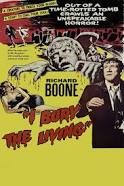
Finished you are with maps and things black and white.
Robert Kraft (Richard Boone) has just been appointed chairman of the “Immortal Hills” cemetery committee. As such he is learning the ropes on what needs to be done to oversee the cemetery. Andy MacKee (Theodore Bikel) has been the caretaker for 40 years and is retiring. In the office he keeps a map displaying the grounds and each gravesite.
Graves already occupied are marked by black pins and sold plots and those that are not yet occupied are marked with white pins. A young couple comes in to purchase plots for themselves. By mistake Kraft puts black pins in their chosen sites instead of white ones. Later he finds out that the young couple who had bought the grave sites died in an automobile accident soon afterwards. His bizarre thought is that by putting the wrong pins on the map he marked them for death.
Trying to dispel the nagging thought, Robert randomly replaces a white pin with a black pin in someone else’s site on the map. Not too long after that the man dies. Robert is starting to become unhinged. Either it’s him that is doing this, or the map. He discusses his concern with Jess Jessup (Herbert Anderson). He is a reporter for the local paper. Jess tries to reassure Robert that it’s just a coincidence. As Robert is increasingly fixated by the map and this perceived power he repeats the experiment over and over. Each time with the same result, the death of the unlucky person whose pin has been replaced. Robert begins to slip into an obsessive madness. His guilt and depression is all consuming. He believes he is cursed.
Police Lt. Clayborne (Robert Osterloh), is at first is skeptical. As more people die he starts to take notice. He can only ignore the situation for so long without believing something is happening. In the hopes that some clue will show itself the police ask Robert to place a black pin on the grave of someone who is known to be in France. They tell him that the man is dead. Once the pin is in place Clayborne confesses that the man is really alive. Now Robert believes he has signed the man’s death warrant. Robert continues his slide into depression. Eventually, obsessed with guilt, he decides that if black pins give him the power of death, white pins might give him the power of life. He replaces all seven of the black pins with white ones. Later that night when he goes to the grave sites of the people he believes he killed, he discovers that they have all been dug up, and the bodies gone. Robert is at the point of suicide.
I can’t help but think that Robert Kraft may have been driven to the brink, but some imbalance may have already been there, either chemically or psychologically, to allow it to be done so easily.
“I Bury The Living” was produced in 1958. It is a low budget independent movie directed by Albert Band. The intense music score heightens the sense of madness felt by Robert Kraft. Although a horror movie, it is also a psychological thriller. The suspense is thick and unrelenting. Richard Boone does a great job as a man on the brink of madness. Throughout the movie the map gets bigger and bigger, a symbol of Robert’s obsession. The movie is dark and rich with psychological imaging. Many people feel it is reminiscent of a Twilight Zone episode and that is basically true. I would even compare it to some of the mysterious undertones used by Hitchcock in some of his psychological thrillers.
Some people thought the ending was a little weak, but that may not be the fault of the movie makers so much as the times in which the movie was made. Had it been made later in the 60’s the film makers would have been freer to explore deeper and darker options. Even so, the power of the map is not just in life and death but in madness. There is still madness here. It’s just reflected somewhere else. Despite how you feel about the ending the movie as a whole is well crafted.

